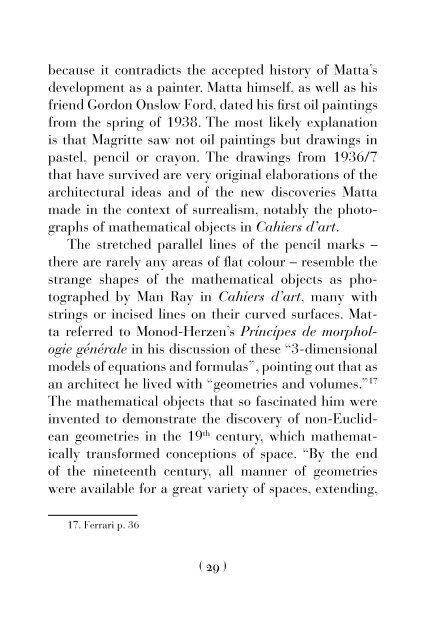Matta-Duchamp
Illustrated catalog featuring full page color illustrations and rare documentary photographs. Published by Galerie Gmurzynska in June 2018 to accompany a special cabinet exhibition at Art Basel 2018. The book includes texts by Professor Dawn Adès and Norman Rosenthal. It coincides with a broader re-evaluation of the importance of Matta internationally as well as of the influence of Duchamp on the work of 20th century artists. Edited and introduced by Krystyna Gmurzynska and Mathias Rastorfer. Essays by Dawn Adès and Norman Rosenthal. Historic interview excerpt by Robert Motherwell. 90 pages with 7 illustrations. Softcover. ISBN: 978-3-905792-09-6
Illustrated catalog featuring full page color illustrations and rare documentary photographs.
Published by Galerie Gmurzynska in June 2018 to accompany a special cabinet exhibition at Art Basel 2018. The book includes texts by Professor Dawn Adès and Norman Rosenthal. It coincides with a broader re-evaluation of the importance of Matta internationally as well as of the influence of Duchamp on the work of 20th century artists.
Edited and introduced by Krystyna Gmurzynska and Mathias Rastorfer.
Essays by Dawn Adès and Norman Rosenthal.
Historic interview excerpt by Robert Motherwell.
90 pages with 7 illustrations.
Softcover.
ISBN:
978-3-905792-09-6
Create successful ePaper yourself
Turn your PDF publications into a flip-book with our unique Google optimized e-Paper software.
ecause it contradicts the accepted history of <strong>Matta</strong>’s<br />
development as a painter. <strong>Matta</strong> himself, as well as his<br />
friend Gordon Onslow Ford, dated his first oil paintings<br />
from the spring of 1938. The most likely explanation<br />
is that Magritte saw not oil paintings but drawings in<br />
pastel, pencil or crayon. The drawings from 1936/7<br />
that have survived are very original elaborations of the<br />
architectural ideas and of the new discoveries <strong>Matta</strong><br />
made in the context of surrealism, notably the photographs<br />
of mathematical objects in Cahiers d’art.<br />
The stretched parallel lines of the pencil marks –<br />
there are rarely any areas of flat colour – resemble the<br />
strange shapes of the mathematical objects as photographed<br />
by Man Ray in Cahiers d’art, many with<br />
strings or incised lines on their curved surfaces. <strong>Matta</strong><br />
referred to Monod-Herzen’s Principes de morphologie<br />
générale in his discussion of these “3-dimensional<br />
models of equations and formulas”, pointing out that as<br />
an architect he lived with “geometries and volumes.” 17<br />
The mathematical objects that so fascinated him were<br />
invented to demonstrate the discovery of non-Euclidean<br />
geometries in the 19 th century, which mathematically<br />
transformed conceptions of space. “By the end<br />
of the nineteenth century, all manner of geometries<br />
were available for a great variety of spaces, extending,<br />
17. Ferrari p. 36<br />
( 29 )

















